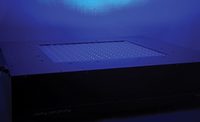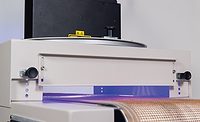UV Curing Technology Helps Transform the Manufacturing of EV Batteries
Offering reduced process times, higher throughput, lower rejection rates, and environment-friendly benefits, UV curing systems are helping to revolutionize lithium-ion battery manufacturing.

Electric vehicles (EV) and lithium-ion batteries are transforming transportation and energy storage sectors with higher efficiencies, zero emissions, reduced noise pollution, and low operating costs. Lithium-ion batteries are preferred over other battery types because they weigh less, charge faster, and pack in higher power density for longer life. These batteries are powering EV technology’s adoption in road, air, sea, and even under water transportation. Lithium-ion batteries are making EVs popular in all transportation sectors including personal, commercial, public, and defence. While lithium-ion battery costs have been a barrier to widespread commercialization, the worldwide push to popularize EV adoption, with attractive government subsidies, EV-related lithium-ion battery usage is continuing to grow rapidly. The accelerating demand is forcing manufacturers globally to make production more efficient.
Manufacturing process innovations powered by UV curing technology offer faster, more reliable, higher quality, and greener production at a fraction of the capital cost. OmniCure® UV Curing Solutions from Excelitas Technologies® are making the EV revolution more cost-attractive and quality more reliable. UV curing is helping complex lithium-ion battery manufacturing by reducing costs and time-to-market, and improving the quality and reliability of the final product.
UV Curing in Battery Manufacturing
According to the latest Technavio market report, the lithium-ion battery market is projected to grow by $58.05 billion between 2020-2025, at a 32.65% CAGR. Market growth is a result of the increasing popularity of rechargeable batteries in consumer electronics and a significant rise in their adoption across different multi-wheeled, commercial-transport electric vehicles. Integrated charging stations are becoming more common, and their expanded footprint is fed by greener power-generation capability using green fuels. This green energy revolution is powering a wider range of eMobility providers. Thus, battery manufacturers anticipate continued accelerated market growth for lithium-ion batteries in the coming years. UV curing methodology is proving to be a much-needed technology, helping battery manufacturers boost bottom lines. The UV curing process is a manufacturing innovation that uses high-intensity, ultraviolet, and visible light to start photochemical reactions that create a superior cross-linked polymers network.
Replacing the use of heat with UV light allows oligomers and liquid monomers to be suitably mixed with a lower percentage of photoinitiators. When these are exposed to light energy, cross-linking occurs very quickly, thereby enabling multiple UV light-curable materials (LCMs). Light-curable adhesives, coatings, and inks deliver many advantages over traditional compounds, which require lengthier drying methods. Thus, advanced UV light-curing technologies are enhancing lithium-ion battery manufacturing speed and throughput. This process reduces the work-in-progress time span and even scrap, contributing to ROI and sustainability initiatives. By enabling 100% in-line inspection, as it is a solvent-free process, UV curing minimizes environmental pollutants.
Advantages of UV-Curing Technology
Product innovators creating new components for today’s EVs and multifaceted electronic items and systems are benefiting from light-curing technology that delivers many benefits. These include:
- Reduced Manufacturing Cycle Times: UV light cures in seconds upon materials’ exposure to UV/visible light, which translates to reduced process and lead times.
- Elimination of Hazardous Waste: Uncured materials purged from a system are typically classified as hazardous waste. Light-curable materials (LCMs), being one-component systems, eliminate the need for off-ratio mixing or purging, enabling manufacturers to fully cure products, thereby eliminating waste. With the reduction of VOC (volatile organic compound) emissions, organizations can conform to EN14001 environmental regulations.
- Reduced Fixed Costs: Dispensing systems costs for one-component materials are significantly lower relative to systems used for two-component materials.
- No More Pot Life Problems: Two-component systems usually have a short pot life measured in minutes/hours after being dispensed. One-component LCMs remain in uncured states until exposed to light energy and are therefore considered to have a vastly increased pot life. Products with shorter pot life need frequent purge cycles, often resulting in clogged mixing elements.
- Superior Capacity: Traditional bonding steps that could have been bottlenecks with slower manufacturing systems are effectively eliminated.
- Reduced Floor Space Requirements: By eliminating the use of humidity chambers, ovens, and rows of racks, manufacturers save on space.
- Simpler and Superior Automation: UV curing shortens the indexing time on a line by enabling online inspection. Reducing fixturing complexities during the curing process also becomes possible. Some adhesives also contain fluorescing additives to allow for easier automated optical inspection.
Increasing Profitability
As people, organizations, and governments embrace EV technology, lithium-ion batteries are at the heart of this movement and are primed for the next generation of evolution. Attracted by consistent and accelerated demand for lithium-ion batteries globally, existing battery manufacturers are expanding operations while new ones join the move forward. UV curing breakthroughs in battery manufacturing are transforming the entire battery manufacturing ecosystem. The many advantages of deploying UV curing breakthroughs have been rigorously tested and globally accepted by regulatory authorities due to their benefits and operational track record.
Industry Pain Points Solved with UV Curing
A key element in lithium-ion battery manufacturing is the high cost of making electrodes. This is due to the large capital investment required for drying ovens, and associated high operating costs of energy, time, and operating complexities, such as recovery charges for very large quantities of VOC solvents.
Assembly of electrodes requires precise application of coatings to facilitate seamless movement of lithium-ions between the anode and cathode. Traditionally, PVDF material was used, with a very time consuming application and drying process and high energy demands from the heated air dryer (>35,000 kW), solvent recovery (>1700 kW), and solvent evaporation (>100 kW), resulting in less-than-ideal yields.
In this multi-stage manufacturing process, the polymer and VOC solvents like NMP or N-methylpyrrolidone are mixed. This polymer-solvent solution is then mixed with carbon and lithium compound active materials in a slurry/paste that is coated onto the current collector. This is cumbersome, as a mixture of 45% or more by weight solvent is needed to fully dissolve polymers. The thermal-oven drying process leads to additional time consumption and cost. This coating is thereafter calendared to a final electrode coating thickness of 20-100 microns. With thinner coatings used in higher power applications and thicker coatings in higher energy applications, the calendaring process helps control void percentage (30-35% is typically the goal) and thickness. These thermal driers can be up to 100 meters in length and need several minutes to completely dry the electrode coatings. The driers and related VOC recovery equipment require capital outlays in excess of $10 million in typical electrode manufacturing plants. Additionally, the slow electrode manufacturing line speed of 12-14 feet/minute is a limiting factor in the lithium-ion battery manufacturing process. In contrast, advanced UV total curing systems can deliver throughput of 100, 200, or even 400 feet/minute.
Understanding UV Curing Technology
Using advanced UV curing technology leads to dramatic cost savings and significant quality enhancements due to multiple technological advancements. For example, when a blend of oligomers, monomers, dispersants, and a UV curable photoinitiator are coated on subject substrates like metal and exposed to the required UV radiation (wavelength and intensity), the free radicals generated react to promote rapid crosslinking and polymerization of oligomers and monomers to produce the required polymer. No solvent is used. At times, lithium-ion battery electrode manufacturing with UV curing technology may need minor liquid carrier quantities to minimize the coating’s viscosity and make application to its current collector easier. This small liquid carrier quantity immediately evaporates under UV lamps, negating the need for specialized recovery equipment.
Manufacturing Cost Reduction
As electrodes account for 63% of a battery cell cost (51% for the cathode electrode; 12% for the anode), next-generation UV-curable binders eliminate the need for industrial dryers and solvents. These energy-efficient UV-curable binders combine with new electrode coating processes using lower UV LED curing systems to reduce production costs by as much as 80%, reducing electrode costs by more than 25%. As UV-curable binder materials are continuously evolving, manufacturers have identified a series of suitable oligomers, monomers, and photoinitiators to use in their formulation. These binders have been used to successfully produce UV-coated electrodes for batteries based on NMC111, NMC632, NMC811, and NMC532 electrode materials.
UV curing has proven to be a game-changer in lithium-ion battery electrode manufacturing, with cost reductions and quality and durability enhancements made possible due to a number of factors:
- UV curing completes the process much faster, in hundreds of milliseconds to several seconds, as compared to tens of minutes needed by traditional solvent-based thermal drying systems. This speeds up output from a continuous manufacturing line by a factor of 10-100. In the case of lithium-ion battery electrodes, this results in a significant benefit that reduces overall speed limitations to coating speed. With today’s advanced coating technologies, the lithium battery electrodes can be processed at significantly faster speeds of 150-200 feet per minute. On the anvil, even more high-tech high-speed coating innovations could deliver speeds of up to 400 feet per minute.
- Advanced UV curing techniques need no solvents to dissolve the polymer, though at times, a carrier or wetting agent may be required. The wetting agent helps dispense/carry the binder, and it vaporizes almost instantly. This means that recovery and/or disposal issues, resource costs, and associated environmental issues are minimized.
- Advanced UV curing systems, even as a retrofit application, are far cheaper than traditional thermal drying ovens and significantly reduce processing costs to a fraction of thermal drying system costs. In comparison to thermal drying systems, a UV curing systems is a fraction of the cost, replaces numerous solvent-based units, increases processing speed by 10 times, occupies much less space, and is significantly more energy efficient. The benefits of advanced UV curing systems reduce the capital costs per unit of electrode manufactured by a factor of 100.
- In traditional, thermal-oven-dried and solvent-based systems, battery producers use single-side coating followed by oven drying. This single-side electrode coating is then repeated on the other side and dried again in the oven. The result is two sides with different drying exposures in the oven; the first-side coating is exposed to the oven twice, and the second-side coating exposed once. However, with current advanced UV curing systems, two-sided coating is accomplished with one side coated and UV cured within seconds of the other side being coated and UV cured. This reduces operating and capital cost by a factor of two. Additionally, this two-sided coating process improves electrode coating consistency and enhances productivity, as the amount of materials lost is significantly less in a UV curing unit that is a few feet long as opposed to a thermal drying system that spreads over hundreds of feet.
- The space-saving UV-curing system’s footprint is significantly less, no more than 1/10th the size a traditional thermal drying system. In the case of lithium-ion battery electrode application, the UV curing system’s footprint is approximately 1/20th of the thermal drying system. Thus, UV curing systems deliver more productivity, with better consistency in a fraction of time and space as compared to thermal systems.
- Compared to traditional thermal drying systems, energy-efficient UV curing systems are far more energy efficient.
Environmental Benefits
Battery pack assembly involves several steps and a variety of materials are used to optimize two critical product attributes: cell retention and vibration control. Switching to UV curable materials reduces VOC generation, speeds up assembly time, reduces assembly costs, and improves reliability. To this end, battery manufacturers are focusing on state-of-the-art adhesives for the demanding environment where EV batteries operate. These adhesives adhere to strict automotive standards including extreme temperature and humidity tolerance, thermal shock, and severe vibration levels.
Breakthrough UV curing methodology is expanding the customer base for lithium-ion batteries by enabling cost-effective and faster production, along with enhanced quality and durability output. As lithium-ion batteries replace other battery types in diverse sectors of transportation and energy storage, lower total operating costs make the switchover more attractive in the long run. Switching commercial vehicles to lithium-ion batteries with increased efficiencies and significantly enhanced power capacity enabled by the latest UV curing breakthroughs, and aided by government subsidies and incentives, will contribute to the reduced consumption of fossil fuels, helping operators save money and boost their contribution to sustainability.
Conclusion
UV curing systems deliver many breakthrough advantages, such as reduced process times, higher throughput, and lower rejection rates, all leading to enhanced battery pack reliability and reduced manufacturing costs. Most importantly, eliminating VOCs can improve the safety of the manufacturing environment. With these product benefits, leading UV curing systems are helping to change the lithium-ion battery manufacturing ecosystem. The rise of lithium-ion battery technology in all-electric vehicles in recent years has led to the use of lithium cells in other sectors, and there is great potential to make this technology more widely used in a whole range of other applications in which energy storage and generation are essential.
Learn more at www.excelitas.com.
Looking for a reprint of this article?
From high-res PDFs to custom plaques, order your copy today!





